Neutron Stars and Pulsars
When stars that initially had between 8 M⊙ and 25 M⊙ explode as supernovae, their expanding cores are stopped by the outer layers into which they slam. The cores recontract and remain intact as highly compressed clumps of neutrons, called neutron stars. Isolated neutron stars, resulting from these explosions, are stable stellar remnants with masses between 1.25 M⊙ and about 3 M⊙.
13-10 The cores of many Type II supernovae become neutron stars
The neutron was discovered during laboratory experiments in 1932. Inspired by the realization that white dwarfs are supported by electron degeneracy pressure, Fritz Zwicky (1898–1974) and Walter Baade (1893–1960) proposed that a similar repulsion between neutrons could support remnant neutron cores. They used the fact that the Pauli exclusion principle also prevents neutrons with identical properties from packing too closely together. When neutrons are pressed together, many of them have to move rapidly (so as not to be identical to their neighbors). This motion provides a pressure, called neutron degeneracy pressure, that equations predict is even greater than electron degeneracy pressure (see Section 12-10) and thus allows stellar remnants with masses beyond the Chandrasekhar limit to be stable.
Most scientists ignored Zwicky and Baade’s theory for years. After all, a neutron star seemed to be a rather unlikely object. To transform protons and electrons into neutrons, the density in the star would have to be equal to nuclear density, about 1017 kg/m3. Thus, a teaspoon full of neutron star matter brought back to Earth would weigh about 1 billion tons. Put another way, neutron star matter is 200 million times denser than matter found in a white dwarf. Furthermore, an object compacted to nuclear density would be very small. A 2 M⊙ neutron star would have a diameter of only 20 km (12 mi) and would fit inside any major city on Earth. The surface gravity on one of these neutron stars would be so strong that the escape velocity would equal one-half the speed of light. All of these conditions appeared to be so outrageous that few astronomers paid any serious attention to the subject of neutron stars—until 1968.
421
In that year, Dame Jocelyn Bell Burnell (1943–), then just Jocelyn Bell, a graduate student in radio astronomy at Cambridge University, noticed that the radio telescope she was using was detecting regular pulses from one particular location in the sky. Careful repetition of the observations demonstrated that the radio pulses were arriving with a regular period of 1.3373011 seconds. The regularity of this pulsating radio source was so striking that the Cambridge team suspected that they might be detecting signals from an advanced alien civilization, which accounts for the name first assigned to it: LGM1 (short for Little Green Men 1). This possibility was soon discarded as several more of these pulsating radio sources, which came to be known as pulsars, were discovered across the sky. The broad distribution of pulsars would require incredibly widespread civilizations, inconsistent with what we have found in our searches for alien intelligence (see Chapter 19). In all cases, the pulsar periods were extremely regular, ranging between 0.2 and 1.5 seconds (Figure 13-18).
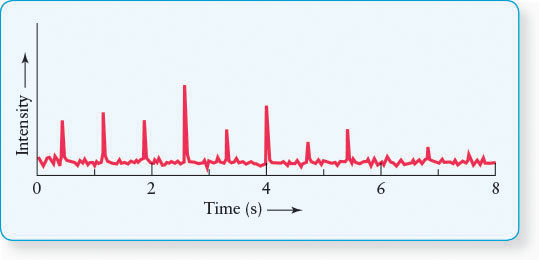
When the discovery of pulsars was officially announced in early 1968, astronomers around the world began proposing all sorts of explanations. Many of these theories were bizarre, and arguments raged for months. We have already ruled out alien civilizations. Astronomers therefore looked for some recurring event in a star’s life. We know that a star sheds matter as it swells to a giant. Perhaps some stars alternately expand and contract, emitting energy as they pulsate. However, this explanation also fails because any star expanding and contracting as fast as a pulsar emits pulses would explode.
Late in 1968, all controversy was laid to rest with the discovery of a pulsar in the middle of the Crab Nebula. In 1054 c.e., Native American, Chinese, and possibly other peoples saw and recorded the appearance of a “guest star” in the constellation of Taurus. When we turn a telescope toward this location, we find the Crab Nebula, shown in Figure 13-19. It looks like the residue of an explosion and is, in fact, a supernova remnant. At the center of the Crab Nebula is the Crab pulsar (Figure 13-19b).
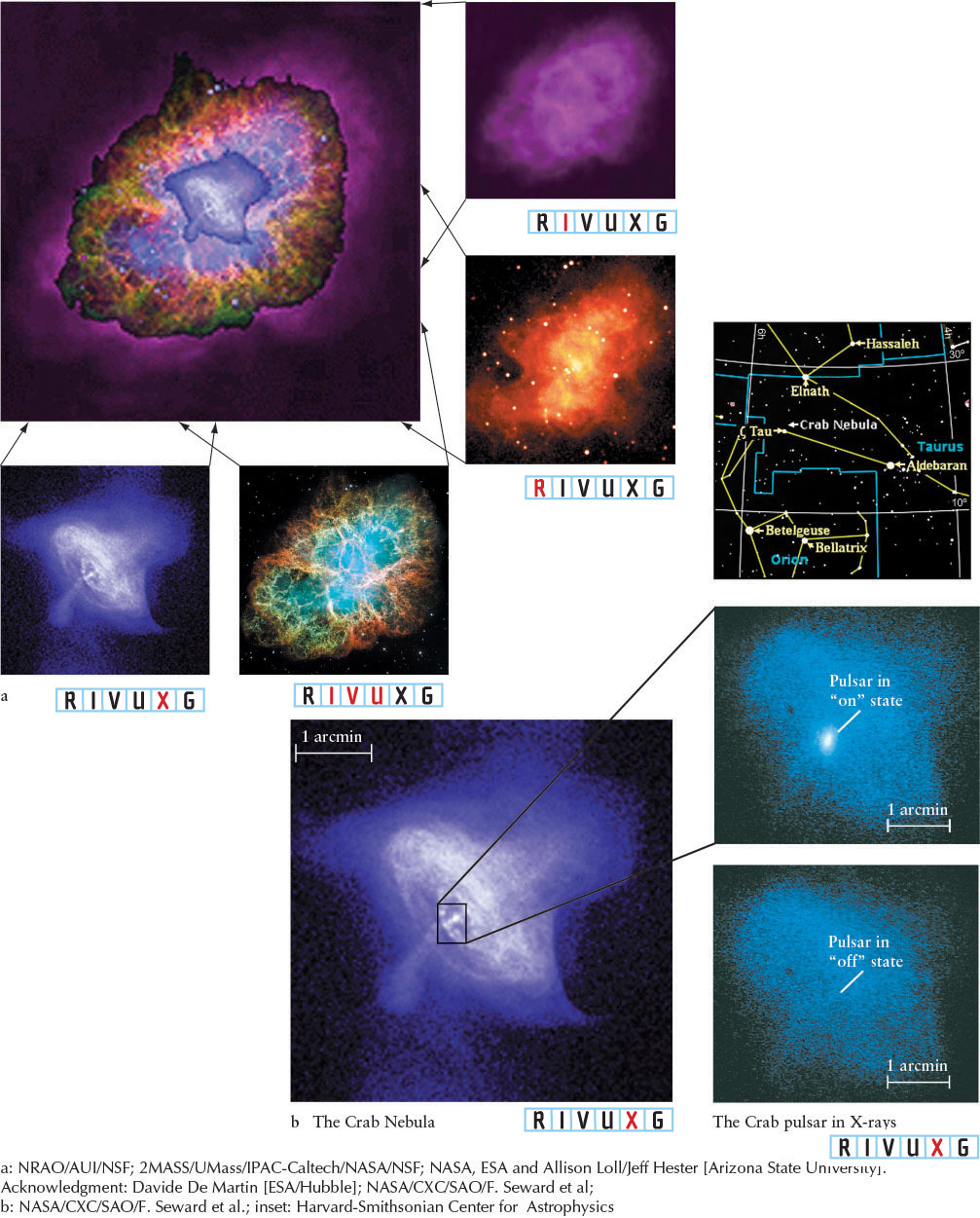

 The Crab Nebula and Pulsar (a) This nebula, named for the crablike appearance of its filamentary structure in early visible-light telescope images, is the remnant of a supernova seen in 1054 c.e. The distance to the nebula is about 6000 ly, and its present angular size (4 by 6 arcmin) corresponds to linear dimensions of about 7 by 10 ly. Observations at different wavelengths give astronomers information about the nebula’s chemistry, motion, history, and interactions with preexisting gas and dust. (b) The insets show the Crab pulsar in its “on” and “off” states. We can see the pulsar in visible light, too. Both its visible flashes and X-ray pulses have identical periods of 0.033 seconds.
The Crab Nebula and Pulsar (a) This nebula, named for the crablike appearance of its filamentary structure in early visible-light telescope images, is the remnant of a supernova seen in 1054 c.e. The distance to the nebula is about 6000 ly, and its present angular size (4 by 6 arcmin) corresponds to linear dimensions of about 7 by 10 ly. Observations at different wavelengths give astronomers information about the nebula’s chemistry, motion, history, and interactions with preexisting gas and dust. (b) The insets show the Crab pulsar in its “on” and “off” states. We can see the pulsar in visible light, too. Both its visible flashes and X-ray pulses have identical periods of 0.033 seconds.
Margin Question 13-8
Question
How big is a neutron star?
With expansion and contraction ruled out, the likely scenario is that pulsars are spinning objects. If the Crab pulsar is spinning, it is spinning too fast to be a white dwarf. Its period is 0.033 seconds, which means that it rotates 30 times each second. At that speed, something as wide as a white dwarf would immediately fly apart. Strengthening the case against pulsars being white dwarfs, astronomers discovered numerous other pulsars rotating even faster, including PSR 1937+21 (PSR for pulsar and 1937+21 for the object’s approximate right ascension and declination), a stellar remnant that pulses 640 times each second. Staying with the belief that pulsars are spinning, astronomers concluded that they must be incredibly compact. Calculations revealed that, if neutron stars exist, they have a sufficiently small diameter to remain intact while rotating as fast as pulsars pulsate. Indeed, this was the only explanation that withstood the process of scientific scrutiny, and, as a result, the theory of neutron stars described earlier was quickly developed.
13-11 A rotating magnetic field explains the pulses from a neutron star
Why are neutron stars rotating so fast, and how do they emit pulses of electromagnetic energy? Based on observations of the rotation of the Sun, Betelgeuse, and other stars, astronomers theorize that many, perhaps most, stars have some angular momentum (rotation) as a result of their forming from swirling ensembles of gas and dust. The Sun, for example, takes nearly a full month to rotate once around its axis. While a star that explodes and forms a neutron star may have been rotating just as slowly, the rotation rate of its collapsing neutron core increases dramatically, just as pirouetting ice skaters speed up when they pull in their arms, as shown in Figure 2-12. Recall from Section 2-7 that this occurs because the total amount of angular momentum in an isolated system (in this case, the neutron core of the star that explodes as a supernova) always remains constant. To conserve angular momentum, the core of a high-mass main-sequence star rotating once a month spins faster than once a second when it collapses to the size of a neutron star.
In addition to rapid rotation, most neutron stars are believed to have intense magnetic fields. In an average star like our Sun, the magnetic field is spread out over millions upon millions of square kilometers just under the star’s surface (see Section 10-5). However, when the core of a star collapses down to form a neutron star, its magnetic field becomes very concentrated, in the same way as stalks of wheat in a field become concentrated when they are gathered in a bundle (Figure 13-20). The strength of a collapsing star’s magnetic field increases to as much as 1015 times Earth’s magnetic field. A magnet that strong located halfway to the Moon would lift iron rods off Earth.

422
423
 The axis of rotation of a typical neutron star is not the same as the axis connecting its north and south magnetic poles (Figure 13-21), just as the magnetic and rotation axes of the Sun and planets (except Saturn) are different from each other. As the neutron star rotates, its powerful magnetic field therefore rapidly changes direction. Like a giant electric generator, the star creates intense electric fields, which act on protons and electrons near its surface. The powerful electric fields channel these charged particles, causing them to flow out from the neutron star’s polar regions, as sketched in Figure 13-21. As the particles stream along the field, they accelerate and emit energy. The result is two very thin beams of radiation that pour out of the neutron star’s north and south magnetic polar regions and sweep through space—a pulsar.
The axis of rotation of a typical neutron star is not the same as the axis connecting its north and south magnetic poles (Figure 13-21), just as the magnetic and rotation axes of the Sun and planets (except Saturn) are different from each other. As the neutron star rotates, its powerful magnetic field therefore rapidly changes direction. Like a giant electric generator, the star creates intense electric fields, which act on protons and electrons near its surface. The powerful electric fields channel these charged particles, causing them to flow out from the neutron star’s polar regions, as sketched in Figure 13-21. As the particles stream along the field, they accelerate and emit energy. The result is two very thin beams of radiation that pour out of the neutron star’s north and south magnetic polar regions and sweep through space—a pulsar.
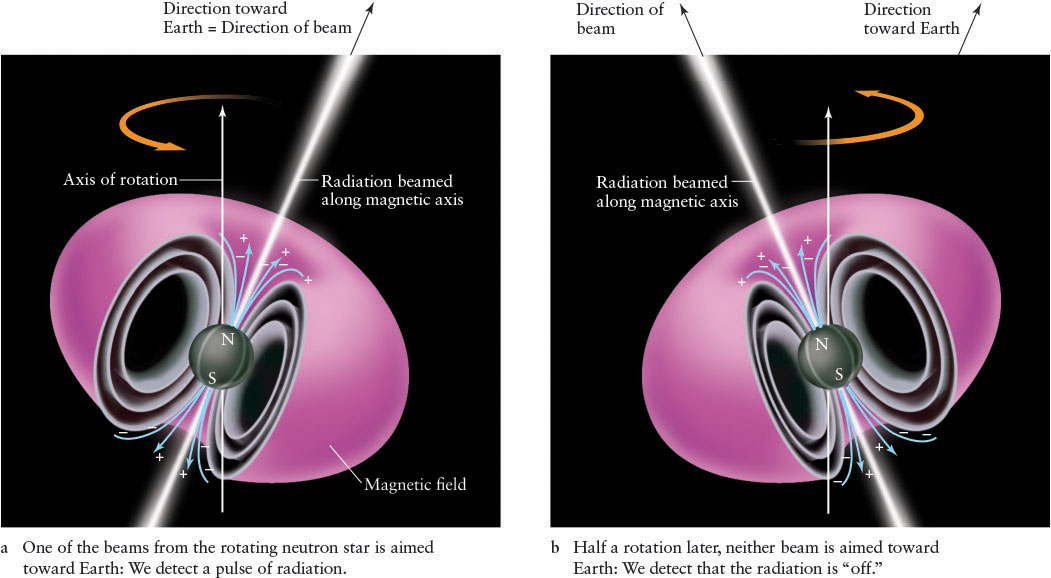
424
This explanation for pulsars is often called the lighthouse model. A rotating, magnetized neutron star is somewhat like a lighthouse beacon. The magnetic field causes nearby gases to accelerate and radiate. Depending on the conditions, this radiation can range from radio waves to gamma rays, and many pulsars emit in more than one spectral range. Calculations indicate that this radiation is beamed, and, as the star rotates, it sweeps around the sky. If Earth happens to be located in the right direction, a brief flash can be observed each time a beam whips past our line of sight. As a result of its neutron star’s rotation, the Crab Nebula flashes on and off 30 times each second (see Figure 13-19).
Margin Question 13-9
Question
If the lighthouse model of pulsars is correct, do we see all nearby pulsars? Why or why not?
The Crab pulsar is one of the youngest known pulsars, its creation having been observed some 960 years ago. Also visibly flashing is the Vela pulsar at the core of the Gum Nebula (see Figure 13-13). The Vela pulsar, with a period of 0.089 seconds, is the slowest pulsar ever detected at visual wavelengths. Because they use some of their energy of rotation to create the pulses they emit, isolated pulsars slow down as they get older. Only the very youngest pulsars are energetic enough to emit visible flashes along with their radio pulses, and the Vela pulsar was created just 11,000 years ago, which is recent in astronomical terms.
13-12 Rotating neutron stars create other phenomena besides normal pulsars
Pulsars typically have magnetic fields about 1012 times stronger than the magnetic field at the surface of Earth. Exceptional circumstances can conspire to raise the field strength a thousand times higher in some pulsars. If the neutron star is very hot (around 1011 K) and spinning very fast (100 times a second) when it forms, convection occurs throughout the neutron star, just as it does for red dwarfs (see Section 12-8). This inward and outward flow of matter, combined with the spin, generates extra magnetic fields via the dynamo effect (see Section 6-4). Combining the neutron star’s two magnetic fields yields a field 1015 times greater than the field at Earth’s surface. The resulting object is called a magnetar, and its effects are dramatic.
Margin Question 13-10
Question
How do the rotation rates of pulsars change with time?
The magnetic fields of a magnetar are so strong that they cause the neutron star’s surface to buckle and emit stupendous bursts of X-rays and gamma rays, along with photons at other wavelengths, that last for fractions of a second. Such magnetars are called soft gamma ray repeaters, or SGRs. (“Soft” means “low energy.” Even so, soft gamma rays are very powerful photons.) Interacting with surrounding gases, the magnetic fields of a magnetar rapidly slow the neutron star’s rotation rate. After 104 years, the body spins only once every 10 seconds, and the SGR activity subsides. Twenty-one magnetars have been observed since 1998, including one in 2004 that released the brightest flash ever seen from outside our solar system. Its photons scattered off the Moon and lit up Earth’s atmosphere.
In 2006, radio astronomers discovered yet another type of emission from rotating neutron stars. Called rotating radio transients, or RRATs, these objects give off bursts of radio and other emissions that last a few thousandths of a second, turn off for minutes or hours, and then spring briefly back to life. The neutron stars involved rotate slowly compared to most pulsars, spinning once every 0.4 to about 10 seconds. The most promising explanation, at present, is that these are older pulsars or magnetars that have slowed down.
13-13 Neutron stars have internal structure
Neutron stars are not composed solely of neutrons. Astronomers have developed a theoretical model for the surface and internal structure of neutron stars (Figure 13-22). A neutron star’s interior has a radius of about 10 km, with a core of superconducting protons and superfluid neutrons. A superconductor is a material in which electricity and heat flow without the system losing energy, whereas a superfluid has the strange property that it flows without any friction. Both super-conductors and superfluids have been created in the laboratory. Surrounding a neutron star’s core is a layer of superfluid neutrons. The surface of the neutron star is a solid, brittle crust of dense nuclei and electrons about  km thick. The gravitational force of the neutron star is so great at its surface that climbing a bump there just 1 mm high would take more energy than it takes to climb Mount Everest.
km thick. The gravitational force of the neutron star is so great at its surface that climbing a bump there just 1 mm high would take more energy than it takes to climb Mount Everest.
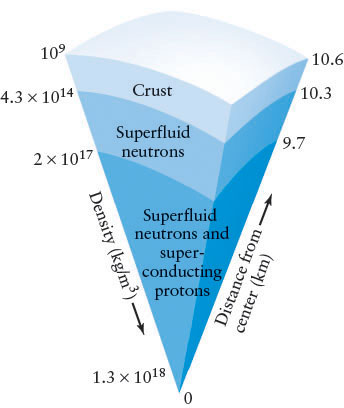
425
Neutron stars also have atmospheres a fraction of a meter thick, as indicated by absorption lines in the spectrum of at least one of them. The absorption lines are believed to be due to scattering of radiation from the neutron star by gases in its atmosphere, just as scattering in the Sun’s atmosphere causes absorption lines in its spectrum.
In 2005, astronomers found indications that some isolated neutron stars expel energy long after they form. In particular, the Cassiopeia A remnant has regions glowing from radiation deposited on them as recently as 50 years ago (some 275 years after the supernova itself). The cause of this activity is still under investigation.
As noted above, an isolated pulsar radiates energy, which causes it to slow down. This “spin down” is not always smooth. As it slows down, it becomes more spherical, and so its spinning, solid surface must readjust its shape. Because the surface is brittle, this readjustment is often sudden, like the cracking of glass, which causes the angular momentum of the pulsar to suddenly jump. Just as Earth’s crust has earthquakes, calculations show that the crusts of rotating neutron stars have equivalent events. When a rotating neutron star (pulsar) undergoes such a quake, its rotation rate suddenly changes to conserve its angular momentum. This change creates a glitch in the rate at which the pulsar is slowing down. Such events have been observed in a number of pulsars (Figure 13-23).
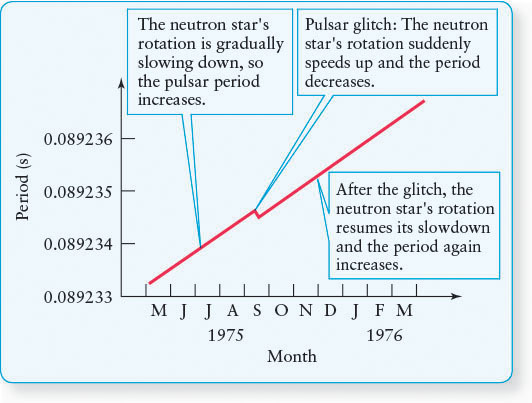
13-14 Some pulsars are in binary systems
Margin Question 13-11
Question
Why do glitches change the rotation rates of pulsars?
While most pulsars appear to be isolated bodies, more than 90 have been discovered with companions (not necessarily other neutron stars). These pulsars are called binary pulsars and are of interest for several reasons. First, many binary pulsars pull mass onto themselves from their companions. This infall causes the pulsar to speed up (like the skater in Figure 2-12 pulling in her arms). As a result of this effect, some pulsars spin nearly a thousand times per second (716 rotations per second is the current record) and are called millisecond pulsars. Second, some pulsars, like the one labeled PSR 1916+13, have compact massive companions, which are often also neutron stars. Observations of binary pulsars with neutron star companions reveal that the two bodies are spiraling toward each other, as predicted by Einstein’s gravitational theory, called general relativity (see Sections 2-1 and 14-4 for details).
In 2004, astronomers observed, for the first time, a pair of pulsars in orbit around each other (Figure 13-24). This discovery provides an exciting opportunity to further test the predictions of general relativity. For example, this theory predicts that these two pulsars should be precessing (the directions that their rotation axes point should be changing; see Section 1-8) and that, like the binary pulsars just discussed, they should be spiraling in toward each other. Observations of this system in the past few years have confirmed these predictions.
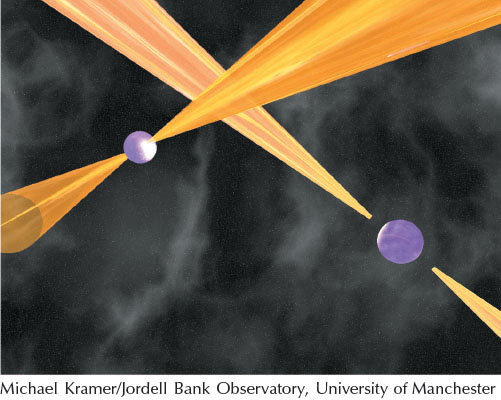
426
13-15 Colliding neutron stars may provide some of the heavy elements in the universe
In Sections 13-5 and 13-6, we discussed nucleosynthesis, the process of creating the heavier elements. We saw how a variety of elements up to iron are created inside massive stars before the supernova occurs and are then ejected into space during the explosion. We also saw that even heavier elements are created and ejected during the supernovae themselves. However, models indicate that supernovae do not create enough of the elements heavier than iron to account for the amounts of these elements found in the universe.
Computer simulations of what happens during collisions of two neutron stars predict that, in these impacts, some of the neutrons are splashed into space, where many of them decay back into protons, fuse together, and help form various elements. The interactions that follow create a variety of heavy elements in amounts consistent with observations. For example, formation of an isotope of the element thulium requires neutron densities only available in neutron stars.
13-16 Binary neutron stars create pulsating X-ray sources
Neutron stars in binary systems may also hold the key to another regular pulse from the sky—pulses from X-ray sources. During the 1960s, astronomers obtained tantalizing X-ray views of the sky during short rocket and balloon flights that briefly lifted X-ray detectors above Earth’s atmosphere. Several strong X-ray sources were discovered, and each was named after the constellation in which it was located.
Astronomers were so intrigued by these preliminary discoveries that NASA built and launched Explorer 42, an X-ray-detecting satellite that could make observations 24 hours a day. The satellite was launched from Kenya (to place it in an orbit above Earth’s equator) in 1970, on the seventh anniversary of Kenyan independence. To commemorate the occasion, Explorer 42 was renamed Uhuru, which means “freedom” in Swahili.
Uhuru gave us our first comprehensive look at the X-ray sky. As the satellite slowly rotated, its X-ray detectors swept across the heavens. Each time an X-ray source came into view, signals were transmitted to receiving stations on the ground. Before its battery and transmitter failed in early 1973, Uhuru had succeeded in locating 339 X-ray sources.
The discovery of pulsars was still fresh in everyone’s mind when the Uhuru team discovered X-ray pulses coming from Centaurus X-3 in early 1971. Figure 13-25 shows data from one sweep of Uhuru’s detectors across Centaurus X-3. The pulses have a regular period of 4.84 seconds. A few months later, similar pulses were discovered coming from a source called Hercules X-1, which has a period of 1.24 seconds. Because the periods of these two X-ray sources are so short, astronomers suspected that they had found rapidly rotating neutron stars.
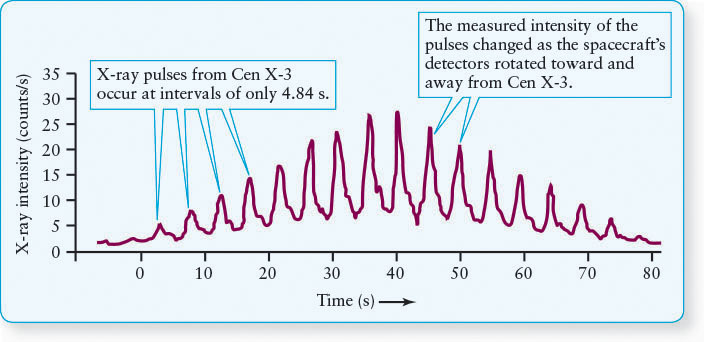
It soon became clear, however, that systems such as Centaurus X-3 and Hercules X-1 are not ordinary pulsars like the Crab or Vela pulsars. Every 2087 days, Centaurus X-3 completely turns off for almost 12 hours. This fact suggests that Centaurus X-3 is an eclipsing binary (see Figure 11-13), and that the X-ray source takes nearly 12 hours to pass behind its companion star.
The case for the binary nature of Hercules X-1 is even more compelling. It has an off state corresponding to a 6-hour eclipse every 1.7 days, and careful timing of the X-ray pulses shows a periodic Doppler shift every 1.7 days. This information provides direct evidence of orbital motion around a companion star. When the X-ray source is approaching us, its pulses are separated by slightly less than 1.24 seconds. When the source is receding from us, slightly more than 1.24 seconds elapse between the pulses.
Astronomers now realize that systems such as Centaurus X-3 and Hercules X-1 are examples of binary systems in which one object is a neutron star. Because all of these binaries have very short orbital periods, the distance between the ordinary star and the neutron star must be small. This proximity enables the neutron star to capture gas escaping from the companion star.
To explain the pulsations of X-ray sources such as Centaurus X-3 or Hercules X-1, astronomers propose that the ordinary star either fills or nearly fills its Roche lobe. Either way, matter escapes from the star. If the star fills its lobe, as in the case of Hercules X-1, mass loss results from direct overflow through the Roche lobe. If the star’s surface lies just inside its lobe, as with Centaurus X-3 (Figure 13-26), a stellar wind carries off the mass. A typical rate of mass loss for the ordinary star in such a pair is approximately 10−9 M⊙ per year.
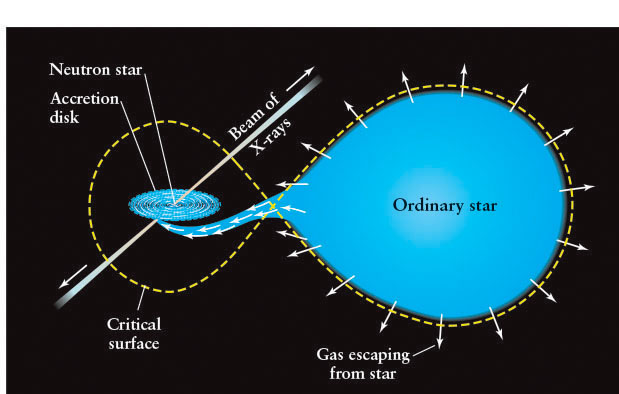
427
The neutron star in a pulsating X-ray source, like an ordinary pulsar, rotates rapidly and has a powerful magnetic field inclined to the axis of rotation (recall Figure 13-21). As the gas from the companion star falls toward the neutron star, the magnetic field funnels the incoming matter down onto its magnetic polar regions. The neutron star’s gravity is so strong that the gas is traveling at nearly half the speed of light by the time it crashes onto the star’s surface. This violent impact creates hot spots at both poles, with temperatures of about 108 K, that emit abundant X-rays with a luminosity nearly 100,000 times brighter than the Sun. Observations of three such X-ray sources in 2005 revealed the impact sites on the neutron stars to range in size from 100 m to 4 km across. As the neutron star rotates, two beams of X-rays from its polar caps sweep around the sky. If Earth happens to be in the path of one of the beams, we can observe this pulsating X-ray source. The pulse period is thus equal to the neutron star’s rotation period. For example, the neutron star in Hercules X-1 completes one rotation every 1.24 seconds.
13-17 Neutron stars in binary systems can also emit powerful isolated bursts of X-rays
Neutron stars can acquire additional mass from a companion star, which leads to the flaring up of the neutron stars. Beginning in late 1975, astronomers analyzing data from X-ray satellites detected sudden, powerful bursts of radiation. The record of a typical burst is shown in Figure 13-27. The source, called an X-ray burster, emits X-rays at a constant low level; then, suddenly and without warning, an abrupt increase occurs, followed by a gradual decline. A typical burst lasts for 20 seconds. Several dozen X-ray bursters have been located, most lying in the plane of the Milky Way Galaxy.
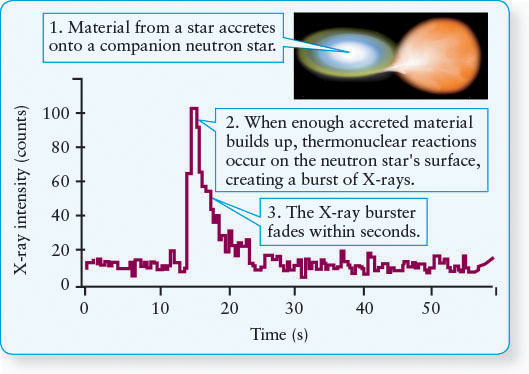
X-ray bursters, like novae, are believed to arise from mass transfer in binary star systems. With a burster, however, the stellar remnant is a neutron star rather than a white dwarf. Gases escaping from the ordinary companion star fall onto the neutron star. The energy released as this gas crashes down onto the neutron star’s surface produces the low-level X-rays that are continuously emitted by the burster.
Margin Question 13-12
Question
Is an X-ray burster similar to a supernova in the evolution of its source?
Most of the gas falling onto the neutron star is hydrogen, which becomes compressed against the hot surface of the star by the star’s powerful surface gravity. In fact, temperatures and pressures in this accreting layer are so high that the arriving hydrogen is promptly converted by fusion into helium. Constant hydrogen fusion soon produces a layer of helium that covers the entire neutron star. When the helium layer is about 1 m thick, helium fusion ignites explosively, and we observe a sudden burst of X-rays. In other words, whereas explosive hydrogen fusion on a white dwarf produces a nova, explosive helium fusion on a neutron star produces an X-ray burster.
Figure 13-28 summarizes the evolutionary history of stars, as discussed in Chapter 12 and this chapter.
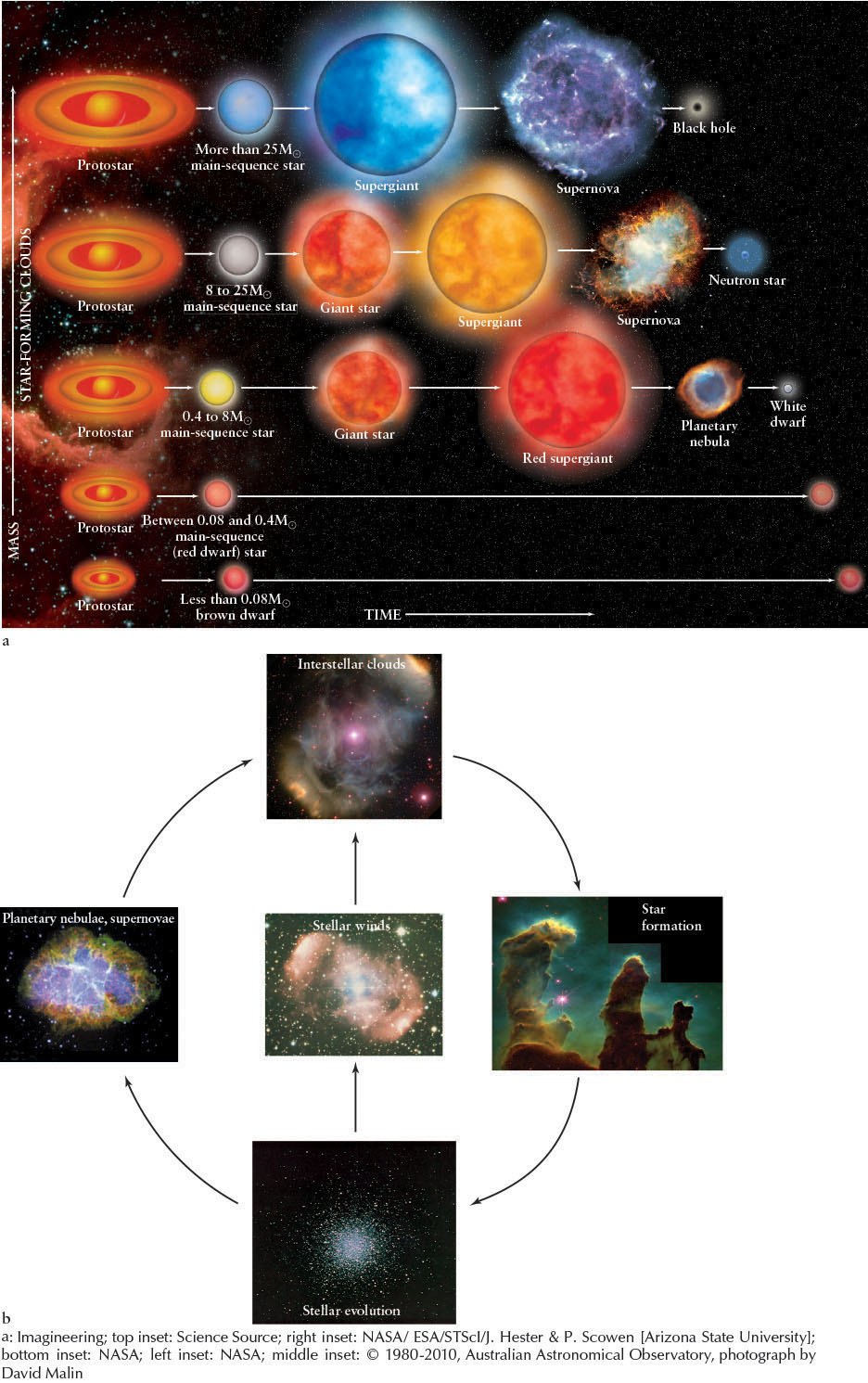
428
429
13-18 Frontiers yet to be discovered
The incredible telescopes now in existence or scheduled to go into operation soon are revolutionizing our understanding of the final stages of star formation. In coming years, astronomers hope to pin down the details of how planetary nebulae, novae, supernovae, and stellar remnants behave. Among specific questions to be answered: What are the details of the physical processes that cause planetary nebulae? Why do planetary nebulae have such a variety of shapes? What causes the hourglass shape of so many stellar remnants? Why are novae composed of many blobs of gas? Do we have a complete understanding of where all the elements and isotopes in the universe are formed?